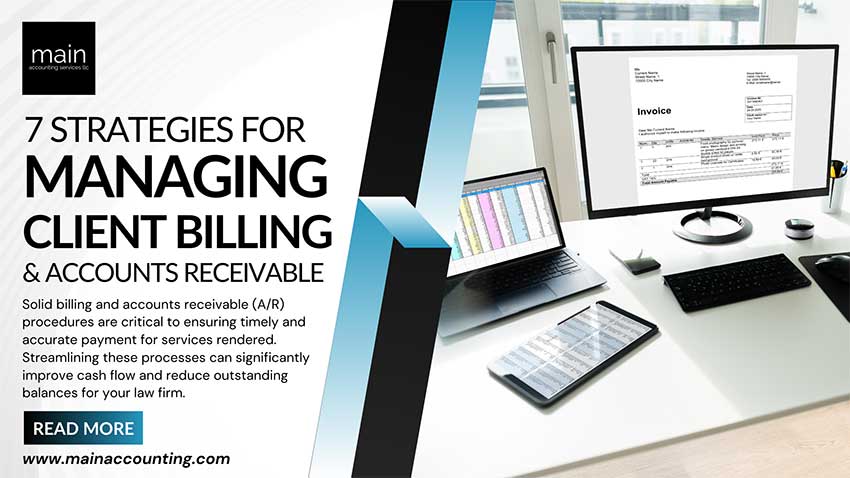Solid billing and accounts receivable (A/R) procedures are critical to ensuring timely and accurate payment for services rendered. Streamlining these processes can significantly improve cash flow and reduce outstanding balances for your law firm.
Billing and A/R should not be a labor-intensive process if your systems are set up properly. These seven strategies will help you create and maintain efficient workflows and use best practices so you can rely on incoming funds on a regular basis.
1. Select the right software.
Choosing a billing software that works with your industry and practice area is an essential first step in creating sound billing practices. Equally important is making sure you are using your software to its fullest capabilities. Be sure to integrate merchant services and set up service codes to eliminate the need for manual typing.
2. Create procedures for each step of the billing process.
There is no need to reinvent the wheel every billing cycle. Main Accounting Services has saved clients many hours per billing cycle by implementing established procedures. For example, if you are paying invoices with client trust funds, follow procedures and best practices. For hourly billing, ensure everyone is entering their time in “real time” so hours do not get missed. Once your billing procedures are clearly delineated, your firm can delegate this as an administrative task.
3. Establish a routine billing cycle.
Waiting until the end of the month to do billing can be overwhelming – and things are much more likely to fall through the cracks. Developing, documenting and implementing a well-thought-out billing process will save your firm time and improve accuracy.
4. Set up automatic billing and payment plans.
Most law firm billing software allows for automatic billing and payment plans. If you are unsure of how to set these up, we can discuss your options and refer you to a billing specialist as needed.
5. Capture and invoice for advanced client costs.
Enter all advanced client costs as they are paid by the firm; this way you won’t miss billing a client for expenses. Invoice clients for advanced client costs as soon as possible – the faster you invoice, the faster you will recover these costs.
6. Manage accounts receivable.
• For flat fees:
o Establish auto reminders for payments.
o Do not start work before getting paid. Your software should tag a matter “on hold” if payment has not been received.
• For Hourly Billing:
o Get paid up front with retainers. Your software should allow users to see if they have worked hours that surpass the amount of funds held in retainers.
o If you still have open and overdue A/R, create a process for collecting these fees or use an outsourced collection agency.
7. Replenish trust balances.
Your billing software should allow you to view trust balances by client. When funds go below your predetermined threshold, you will want to send trust replenishment requests. If your software does not handle this automatically, setting up routine tasks to review balances should help. If you are unsure of how to do this, we are happy to discuss your options and, if necessary, refer you to a trust request and A/R specialist.
At Main Accounting Services, we understand the challenges and importance of solid trust accounting procedures and workflow. To find out more about how we help growing law firms increase their profitability and success, schedule a free consultation here.

